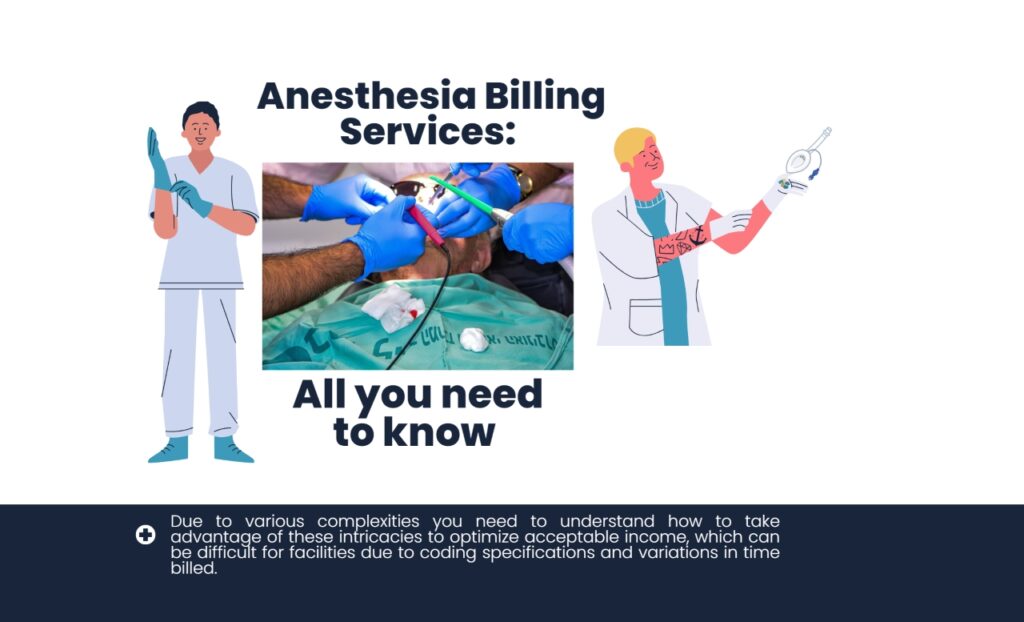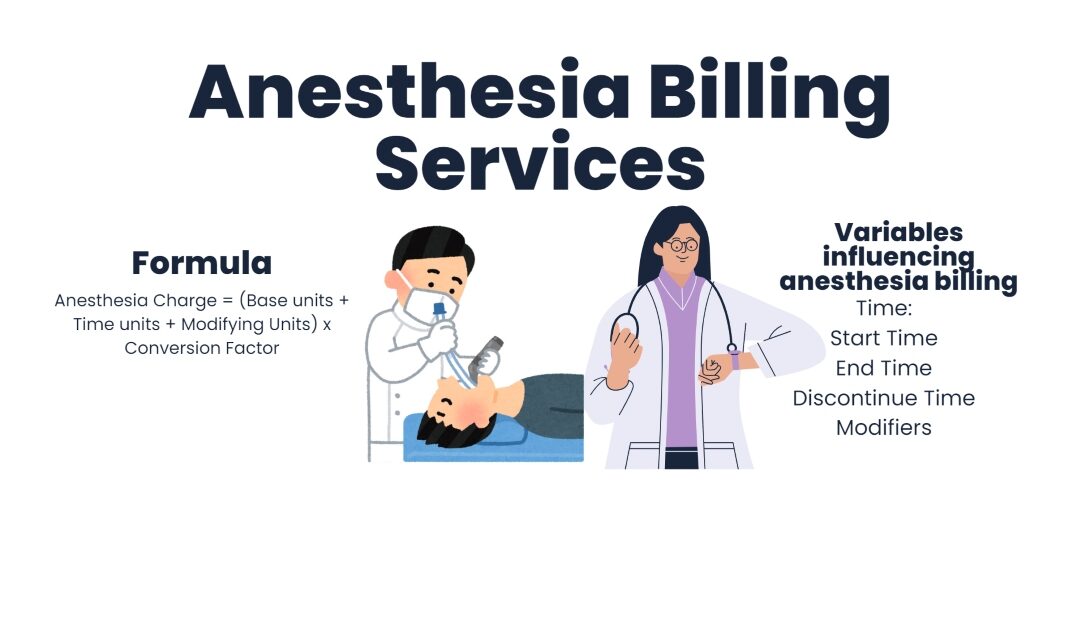Table of Contents
In the medicine field, anesthesia billing is a complex and challenging area. The medical billing sector, anesthesia billing, has led the way since 1991. Medical billing is accountable for much more than just your healthcare practice’s revenue. Due to various complexities, you need to understand how to take advantage of these intricacies to optimize acceptable income, which can be difficult for facilities due to coding specifications and variations in time billed. Your healthcare practice can hire extra employees and eventually raise the caliber of services, making a good profit. Errors in your medical billing procedure can result in lost revenue, postponed payments, and denials of claims.
Given that certain treatments call for more anesthesia and, in some cases, it requires less, so for these complicated cases, the anesthesia billing is crucial. While the entire body must be sedated for certain procedures, another procedure just requires numbing of a specific body area. This complicates and challenges the entire billing procedure.
Therefore, your anesthesiology practice maintains all facets of medical billing. Ensuring validated anesthesia services requires starting with educating your facility’s practitioners and personnel about the documentation needs. This entails teaching your personnel and practitioners about the documentation standards and healthy practices in addition to maintaining accurate and comprehensive records to prevent any problems with claim submission. But that is insufficient. Anesthesiology is the practice of administering a mild sedative to patients in order to keep them unconscious during surgery. Hence, correct understanding of all the codes associated with various anesthetic uses is necessary in order to keep correct records.
Healthcare changes also affect anesthesia billing. According to research by the Centers for Medicare and Medicaid Services (CMS), anesthetic billing rates are expected to increase by 3% between 2021 and 2023. This development is a result of growing regulatory requirements, ASA levels rising as a result of population aging, and improvements in anesthetic procedures. We will go over the specifics of anesthesia billing, along with suggestions for enhancing medical billing in anesthesiology practices.

How To Bill For Anesthesia
Anesthesiology’s medical billing procedures can vary slightly from standard procedures. A few variables that affect anesthesia billing are time, procedure complexity, and modifiers. Usually, a formula is used to determine the charges.
Anesthesia Charge = (Base units + Time units + Modifying Units) x Conversion Factor
This formula determines your price based on four important factors:
Base Unit: The anesthetic rates for a given operation code are verified using base units. Complex and challenging operations frequently have a higher base unit. This enables the user to make a comparison between the basic unit data and the payment amount on a bill line item.
Time Unit: Although a time unit’s length varies based on location, it typically lasts for 15 minutes. Time passes while the patient receives continued treatment from the doctor, who will stay on board until the patient is handed over and the report is completed.
Modifying Unit: Modifying units cover medical emergencies or special circumstances pertaining to a patient. This set of modules addresses a number of topics, such as field avoidance, controlled hypotension, hypothermia, atypical positions, patient ages, physical conditions, CRNA supervision, and many others.
Conversion Factor: The price attributed to every unit is the conversion factor. This varies based on where the supplier is located. The “conversion factor” is yearly modified and varies according to the region.
Variables influencing anesthesia billing
Anesthesia records are comprehensive documents that contain all the details pertaining to the administration of anesthesia, including the kind and dosage of anesthetic used, the length of the anesthesia, and any difficulties or interventions that may have arisen during the surgery.
Time: In anesthesiology, time is everything. For invoicing purposes, it is therefore further split down for accuracy.
Start Time: The operation is indicated to begin at the start time. This encompasses the duration required by an anesthesiologist to get the patient ready for procedures such pre-anesthesia sedation, monitor installation, etc. It does not, however, include the time spent on medical history review, patient intake, or any other pre-procedure activities.
End Time: The anesthetic treatment ends at stop time. At this point, the patient’s care is turned over to another specialist and they are admitted to the Post-Anesthesia Care Unit (PACU). Up until the patient is effectively moved into post-anesthesia care, PACU time is billed. For billing purposes, it is critical that this time be recorded.
Discontinue Time: Discontinuous time is any interval of time between the insertion of an IV and surgery, or between receiving relief and changing providers. The hours and minutes for this time must be written exactly. There is no chargeable time for the post-evaluation period. When an anesthesiologist leaves a case in the middle of it, for example, or when there are problems with relief, it is preferable not to count discontinuous time.
Modifiers: Modifiers are two-character codes that can be used to change claim data or adjust payments. Most billers are familiar with typical modifiers and when to apply them. Modifiers assist in preventing unbundling or duplicate claims. They facilitate speedier claim filing and help improve reimbursement accuracy.
How to Improve Anesthesia Billing?
Now that you are aware of how anesthesia bills are computed, let us review the actions you can take to enhance your anesthesia billing:
- Precise and comprehensive documentation is the most indispensable requirement for anesthesia billing. Your claim will be denied if there are any crucial patient health records, anesthetic duration, or operation complexity lacking from your evidence.
- All facets of healthcare are benefiting from technology. In this digital era, you can enhance your medical billing procedure by implementing medical billing software. With the use of right technology, you can automate repetitive operations, monitor claims, handle denials, lighten your workload, and produce reports. As a result, your billing cycle will become simpler.
- In the medical billing and coding process, regular communication between staff members and billers helps to prevent discrepancies and handle any potential problems.
- Remember, selecting right software is not enough; you also need a dependable and knowledgeable staff to manage procedures. To handle the complex anesthesia billing procedures, you should provide your employees regular training on the newest anesthesia billing trends, given how frequently healthcare regulations change.
- You can find strategy gaps and make necessary adjustments by conducting regular audits. While external audits might provide a fresh viewpoint, having an audit team can help you monitor your billing procedure.
Contracting Out Services for Anesthesia Billing
You will never make a more important decision for your practice than to outsource medical billing. When receiving services that may not be covered by Medicare, beneficiaries are required to sign an Advanced Beneficiary Notice (ABN). You can guarantee on-time payments and prevent mistakes by doing this. It will offer you comfort to know that your claims will not be rejected and that your reimbursements will go up if you outsource your billing to experts like MD Compliance Solutions. We will help you in advance with your medical billing thanks to their vast knowledge in rejection management, audits, medical billing and coding, and compliance.
In summary
To put it briefly, a hospital’s capacity to make money, comply with regulations, and maintain its financial stability all depend on its ability to accurately bill for anesthetic services. It is therefore a field that needs careful thought and consistent work to advance. It might be difficult to make your way through the complicated world of medical billing. Luckily, you can rely on us. In their extensive experience in anesthesia coding and billing, our staff will make sure the financial stability of your practice is maintained. You may concentrate on providing high-quality patient care at the same time.

Read More: Key to Effective Cardiology Billing and Coding
Reference 1,

